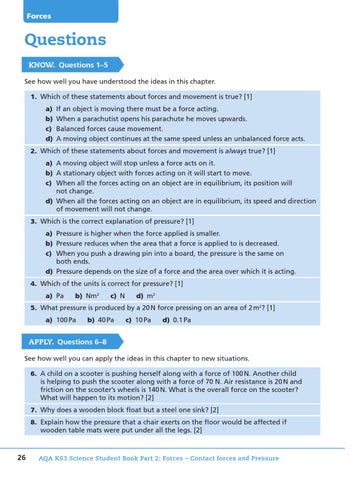Forces
Questions KNOW. Questions 1–5 See how well you have understood the ideas in this chapter. 1. Which of these statements about forces and movement is true? [1] a) b) c) d)
If an object is moving there must be a force acting. When a parachutist opens his parachute he moves upwards. Balanced forces cause movement. A moving object continues at the same speed unless an unbalanced force acts.
2. Which of these statements about forces and movement is always true? [1] a) A moving object will stop unless a force acts on it. b) A stationary object with forces acting on it will start to move. c) When all the forces acting on an object are in equilibrium, its position will not change. d) When all the forces acting on an object are in equilibrium, its speed and direction of movement will not change. 3. Which is the correct explanation of pressure? [1] a) Pressure is higher when the force applied is smaller. b) Pressure reduces when the area that a force is applied to is decreased. c) When you push a drawing pin into a board, the pressure is the same on both ends. d) Pressure depends on the size of a force and the area over which it is acting. 4. Which of the units is correct for pressure? [1] a) Pa
b) Nm2
c) N
d) m2
5. What pressure is produced by a 20 N force pressing on an area of 2 m2? [1] a) 100 Pa
b) 40 Pa
c) 10 Pa
d) 0.1 Pa
APPLY. Questions 6–8 See how well you can apply the ideas in this chapter to new situations. 6. A child on a scooter is pushing herself along with a force of 100 N. Another child is helping to push the scooter along with a force of 70 N. Air resistance is 20 N and friction on the scooter’s wheels is 140 N. What is the overall force on the scooter? What will happen to its motion? [2] 7. Why does a wooden block float but a steel one sink? [2] 8. Explain how the pressure that a chair exerts on the floor would be affected if wooden table mats were put under all the legs. [2]
26
AQA KS3 Science Student Book Part 2: Forces – Contact forces and Pressure
SB2_Ch1.indd 26
06/02/2017 10:31
